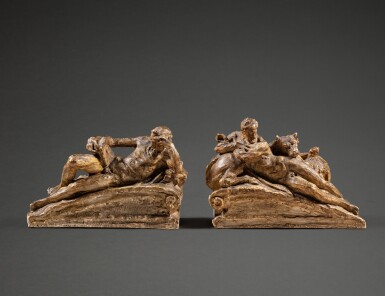European Sculpture and Works of Art
European Sculpture and Works of Art

Jean-Baptiste Carpeaux
La Science and L'Agriculture (Allegories of Science and Agriculture)
Lot Closed
July 4, 11:49 AM GMT
Estimate
30,000 - 40,000 GBP
Lot Details
Description
Jean-Baptiste Carpeaux
Valenciennes 1827 - 1875 Courbevoie
La Science and L'Agriculture (Allegories of Science and Agriculture)
patinated plaster
La Science: 24.2 by 39cm.
L'Agriculture: 26.5 by 39cm.
These elegant reclining figures are rare plaster casts of Carpeaux's sketches for his personifications of Science and Agriculture from his group, Imperial France Bringing Light to the World and Protecting Science and Agriculture, which was executed in 1865 on the orders of Napoleon III for the pediment of the south facade of the remodelled Pavillon de Flore at the Louvre.
In conceiving the models, Carpeaux near directly borrowed the figures from Michelangelo's New Sacristy tombs in San Lorenzo, Florence, particularly the figure of Lorenzo de' Medici (for the Science) and, to a lesser extent, Giuliano de' Medici (for the Agriculture). The use of Michelangelo's models as inspiration for the two reclining figures allowed Carpeaux to create a radical and successful sculptural group which avoids a pedestrian tripartite arrangement. Édouard Papet has commented, 'The dynamic combination of the drapery billowing in the wind at France's back and the imperial emblem enveloping the reclining male figures - inspired by Michelangelo - structures the whole pediment with rhetorical eloquence. The muscular physicality of the three human figures creates a powerful image that is legible from the ground and that renews the motif of apotheosis in an eclectic style' (op. cit., pp. 123-124).
Carpeaux was criticised by some contemporaries for relying so obviously on Michelangelo's models, but he was defended by Rodin, who, in 1912, declared his 'great admiration for this pediment of the Pavillon de Flore, for this France raising in full daylight into the sky, with incomparable lightness, while, thanks to an ingenious idea, her outspread wings wrap in a deep and magnificent shadow the two figures calmly symbolising Work and Thought [sic]... They recall the Medici tombs, but this is so beautiful from the distribution of planes and understanding of the light that one does not notice; the composition carries the whole' (as quoted by Papet, op. cit., p. 128).
The present plasters are amongst a handful of casts made by Carpeaux's family as documentary studies after his death. Other casts are in the Art Institute of Chicago (inv. no. 1957-247); the musée des Beaux-Arts, Lyon (inv. no. B.1484); the Petit Palais, Paris (inv. no. PPS 1614); the musée des Beaux-Arts, Valenciennes (cast from the atelier molds in 1931; inv. no. Val. no. 122); and the musée du Louvre, Paris (inv. no. RF 1977).
RELATED LITERATURE
M. Poletti and A. Richarme, Jean-Baptiste Carpeaux, sculpteur, catalogue raisonné de l'oeuvre édité, Paris, 2003, no. ES 1, p. 152; E. Papet, J. D. Draper, Carpeaux 1827-1875: Un sculpteur pour l'empire, exh. cat. Musée d'Orsay and Metropolitan Museum of Art, Paris and New York, pp. 99-101, nos. 57-58
